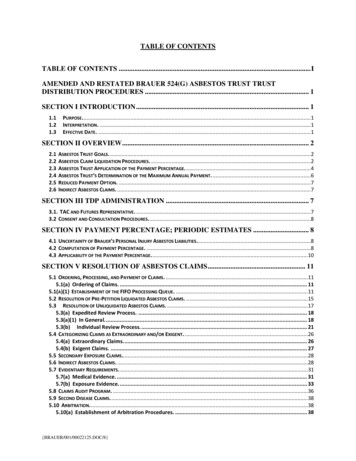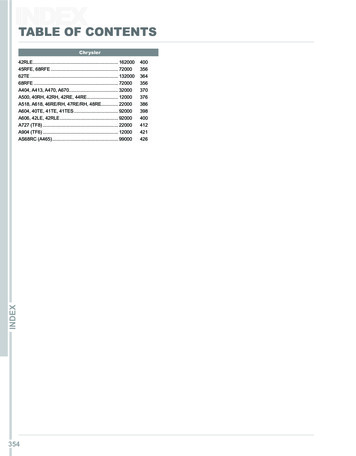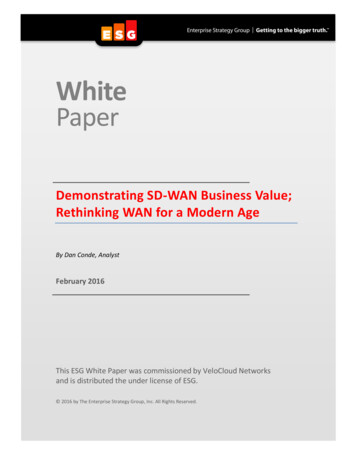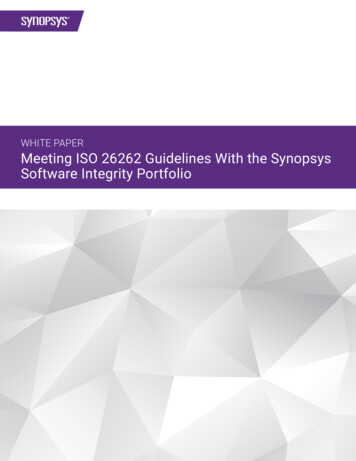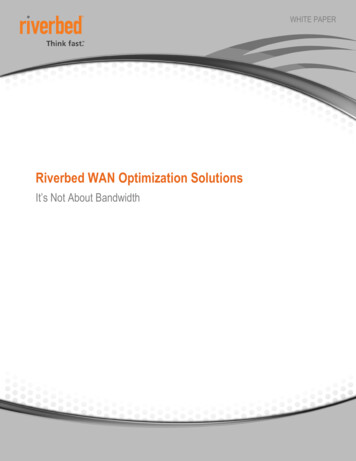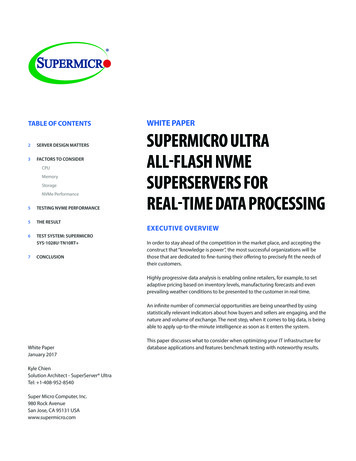
Transcription
TABLE OF CONTENTS2SERVER DESIGN MATTERS3FACTORS TO CONSIDERCPUMemoryStorageNVMe Performance5TESTING NVME PERFORMANCE5THE RESULT6TEST SYSTEM: SUPERMICROSYS-1028U-TN10RT 7CONCLUSIONWHITE PAPERSUPERMICRO ULTRAALL-FLASH NVMESUPERSERVERS FORREAL-TIME DATA PROCESSINGEXECUTIVE OVERVIEWIn order to stay ahead of the competition in the market place, and accepting theconstruct that “knowledge is power”, the most successful organizations will bethose that are dedicated to fine-tuning their offering to precisely fit the needs oftheir customers.Highly progressive data analysis is enabling online retailers, for example, to setadaptive pricing based on inventory levels, manufacturing forecasts and evenprevailing weather conditions to be presented to the customer in real-time.An infinite number of commercial opportunities are being unearthed by usingstatistically relevant indicators about how buyers and sellers are engaging, and thenature and volume of exchange. The next step, when it comes to big data, is beingable to apply up-to-the-minute intelligence as soon as it enters the system.White PaperJanuary 2017Kyle ChienSolution Architect - SuperServer UltraTel: 1-408-952-8540Super Micro Computer, Inc.980 Rock AvenueSan Jose, CA 95131 USAwww.supermicro.comThis paper discusses what to consider when optimizing your IT infrastructure fordatabase applications and features benchmark testing with noteworthy results.
Supermicro Ultra All Flash NVMe SuperServersFor Real-Time Data ProcessingSupermicro Ultra All-FlashSuperServers for Databases Highest performance per U (densityoptimized) Workload flexibility Scalability Hot-swap accessibility Low latency Lower total cost of ownership Ease of qualificationSERVER DESIGN MATTERSThe hardware you choose needs to be able to facilitate extreme data throughputat hyper speed while optimizing your chosen storage in order to guaranteeinstantaneous access to/utilization of volumes of structured and unstructured data.Previously, the kind of infrastructure able to process real-time data en massewas only accessible to establishments having IT budgets generous enough tocover the prohibitive price of custom-built equipment. With this in mind, and anunderstanding of just how crucial it has become to a growing number of verticalmarkets to rapidly extract and apply business intelligence, Supermicro hasdeveloped a range of commercial off-the-shelf SuperServers able to provide thelevels of speed, availability, concurrency and recoverability that a complex databaseschema requires.Supermicro's Ultra SuperServer range includes a 10-drive All-Flash NVMe systemin a 1U form factor (Figure 3), and 24- and 48-drive All-Flash NVMe systems ina 2U form factor (Figures 1 & 4 and Figures 2 & 5) architected to offer unrivaledperformance, flexibility, scalability and serviceability and therefore ideally suited todemanding enterprise-sized data processing workloads.Figure 1. Supermicro 2U Ultra SuperServer 2028U-TN24R4T featuring 24 hot-swap NVMe/SAS3 hybrid drive bays.Figure 2. Supermicro Simply Double 2U SuperStorage 48 NVMe2028R-NR48N featuring additional hot-swap NVMeSSDs arrayed in a patented Riser Bay for easy accessand servicing.With up to 165W TDP (Thermal Design Power) supported, the Ultra SuperServer range heightens processing speed while extending the life span of one of the mostvital components of the infrastructure. The frequency and performance optimizedCPU SKUs are able to effectively dissipate the increased heat generated from highworkload CPUs owing to an advanced cooling design.Ultra SuperServers can be easily configured and reconfigured for a wide varietyof workloads due to a number of Ultra Riser alternatives, including built-in 1G,10GBASE-T, 10G SFP , 40G, and InfiniBand; plus support for add-on SAS 3 HW/SWRAID controllers; and additional PCI-E 3.0 slots.January 20172
Supermicro Ultra All Flash NVMe SuperServersFor Real-Time Data ProcessingFACTORS TO CONSIDERAn IT infrastructure that is able to respond immediately to simultaneous userrequests or answer multi-dimensional analytical queries in real-time requiresa combination of one or more online transaction processing (OLTP) or onlineanalytical processing (OLAP) applications running in what is usually a highlyspecialized environment. The specific use case will determine the compilation ofelements to some extent, but the factors to consider will include:CPUFigure 3. Supermicro 1U Ultra SuperServer 1028U-TN10RT Choosing the right CPU is vital to ensure optimal performance. The latestgeneration CPUs, designed for real-time analytics, are able to query many terabytesof data and provide results in seconds.Features to consider include responsiveness, reliability and scalability to insure fast,zero down-time processing, especially for mission critical workloads that need tobe able to scale up seamlessly.MEMORYFigure 4. Supermicro 2U Ultra SuperServer 2028U-TN24R4T The list of advantages of using in-memory databases is growing as demand forgathering business intelligence increases and supporting technologies develop.The need for intelligence based on the analysis of data, at speed, in order to predictmarket mood and perceptions, and react to that market, is becoming the norm.For example, in order to make sound business decisions to maximize gains on agiven trading day, a financial institution could use financial modeling to build apredictive model that takes a number of pertinent variables into consideration,thus creating a theoretical representation of future, 'real world' financial situations.And of course, market conditions are ever changing, which means the predictivemodel will need constant fine tuning to remain relevant.In-memory processing involves placing data in the system's RAM (Random AccessMemory) in order to provide lightning-fast response times to queries, frommultiple, concurrent users, and produce instantaneous results.DDR4 (Double Data Rate 4th generation) RAM chips support transfer rates of up to2.4 billion transfers per second: a significant memory boost at a lower voltage thantheir DDR3 predecessors. Still, big workloads devour RAM. This can mean large bitesare taken out of your IT budget for a system that can deliver the DRAM capacitiesneeded.January 20173
Supermicro Ultra All Flash NVMe SuperServersFor Real-Time Data ProcessingSTORAGEDatacenter Managers will tell you that storage I/O performance is invariably whatcauses bottlenecks when it comes to data extraction and analysis because thestorage is required to perform in intense bursts. This is where flashed-based storagecomes into its own.Figure 5. Supermicro Simply Double2U SuperStorage 48 NVMeSSG-2028R-NR48NNVMe, an interface specification for accessing non-volatile storage media viaPCI Express (PCI-E) bus, is able to provide up to 70% lower latency and up to sixtimes the throughput/IOPs when compared with standard SATA drives. And, asthe technology is more widely adopted, it's becoming more affordable. In someinstances, the 600% boost in performance that NVMe delivers will only cost 6-7%more than a traditional SATA SSD.Flash can be introduced as capacity stores or as caching devices to improveperformance, reduce latency and increase IOPs.NVME PERFORMANCEFigure 6 below compares Supermicro SYS-1028U-TN10RT with 10 NVMe SSDs tothe industry standard 1U 10 bay server with 10 SAS3 SSDs.The result: a noteworthy12x performance gain in read IOPS and 10x performancegain in write IOPS.Performance in 10RT (NVMe)3,594,60010ximprovement359,235WriteIndustry Standard Server(SAS SSD)Figure 6. Performance in IOPs - Supermicro 1U Ultra SuperServer 1028U-TN10RT vs. industry standard 1U server.January 20174
Supermicro Ultra All Flash NVMe SuperServersFor Real-Time Data ProcessingSuperServer 1028U-TN10RT System Configuration forBenchmark Test CPU2x Intel Xeon processor E5-2680 v4(35M Cache, 2.00 GHz) Memory288 GB RAM Storage10x HGST SN100 3.2TB NVMe(Database); 1x Intel S3700 Operating SystemMicrosoft Windows Server 2012 Database ServerMicrosoft SQL Server 2014TESTING NVME PERFORMANCETo test just how well the All-Flash Ultra range performs when it comes to databases,the SYS-1028U-TN10RT system with10 U.2 NVMe SSD drives was chosen toprocess a database schema based on a SQL server 2014 and Windows Server 2012R2 implementation, and was set up to mimic the workload created by 56 usersmonitoring stock moving through 5000 warehouses.As shown in Figure 7 below, nine of the drives were assigned a database file each,using the HammerDB load testing tool designed to simulate heavy transactionprocessing and business intelligence workloads.SYS-1028U-TN10RT Figure 7. Graphical representation of nine of the SSD drives mapped to onedatabase each.THE RESULTWith 90% of the most highly available storage dedicated to database hosting, the1028U-TN10RT produced an industry-first result of 4.9 million Transactions PerMinute (TPM). An exceptional feat for a 1U off-the-shelf server requiring minimalconfiguration.Figure 8. Performance results achieved in the HammerDB test.January 20175
Supermicro Ultra All Flash NVMe SuperServersFor Real-Time Data ProcessingTEST SYSTEM: SUPERMICRO SYS-1028U-TN10RT The only 1U server on the market able to accommodate up to 10 U.2 NVMeSSD drives and using a total of 40 PCI-E 3.0 lanes from two CPUs to provide fullbandwidth (PCI-E x4) to each NVMe SSD, the 1028U-TN10RT (Figures 9 and 10)provides enterprise-class performance right where it's needed.Figure 9. Performance and accessibility: 10 2.5" Hot-swappable Drive Bays: 6NVMe ports and 4 NVMe/SAS3 hybrid ports for optional SAS3/SATA3.Figure 10. Low power consumption: 1000W Titanium Level (96%) RedundantPower Supplies.January 20176
Supermicro Ultra All Flash NVMe SuperServersFor Real-Time Data ProcessingFOR MORE INFORMATIONCONCLUSIONSupermicro SuperServer 1028U-TN10RT 8/sys-1028u-tn10rt.cfmThe server design you choose to house the components required for enterprisedata processing workloads is as important as the components themselves.Supermicro SuperServer 2028U-TN24R4T 8/SYS-2028U-TN24R4T.cfmIntel Xeon Processor E5-2600 v4 ssors/xeon/xeon-e5-solutions.htmlOnly Supermicro offers a powerful range of All-Flash solutions to allow you runmore workloads, in less time, and using fewer resources in order to really optimizethe performance of each element of the system.Contact your Supermicro sales representatives today to find out more about howour new generation X10 All-Flash Ultra SuperSever range can help your businessturn the wealth of data at your fingertips into the tangible profits that come frompredicting and responding to the changing needs of your customers, in real-time.Intel NVMe ves/solid-state-drives-ssd.htmlJanuary 20177
About Super Micro Computer, Inc.Supermicro (NASDAQ: SMCI), the leading innovator in high-performance, high-efficiency server technology is a premier provider ofadvanced server Building Block Solutions for Data Center, Cloud Computing, Enterprise IT, Hadoop/Big Data, HPC and EmbeddedSystems worldwide. Supermicro is committed to protecting the environment through its “We Keep IT Green ” initiative and providescustomers with the most energy-efficient, environmentally-friendly solutions available on the market.www.supermicro.comAbout HammerDBHammerDB is a graphical open source database load testing and benchmarking tool built for Linux and Windows and used to testdatabases running on any operating system.The tool, which utilizes built-in workloads based on industry standard TPC-C and TPC-H online transaction processing benchmarks tomimic ‘real-life’ conditions is automated, multi-threaded and extensible. HammerDB features dynamic scripting support, transactionand CPU monitors, and capture and replay for Oracle databases while supporting Oracle, SQL Server, DB2, TimesTen, MySQL, MariaDB,PostgreSQL, Greenplum, Postgres Plus Advanced Server, Redis and Trafodion SQL on Hadoop.www.hammerdb.comThe information contained in this document is subject to change without notice.Results are provided for informational purposes only. Any difference in system hardware or software design or configuration may affectactual performance. Performance tests are measured using specific computer systems, components, software, operations, functions, andworkloads. Any change to any of those factors may cause the results to vary. You should consult other information and performance teststo assist you in fully evaluating your contemplated purchases, including the performance of that product when combined with otherproducts.No part of this document covered by copyright may be reproduced in any form or by any means — graphic, electronic, or mechanical,including photocopying, recording, taping, or storage in an electronic retrieval system — without prior written permission of thecopyright owner.Supermicro, the Supermicro logo, Building Block Solutions, We Keep IT Green, SuperServer , TwinPro , TwinPro² , SuperDoctor aretrademarks and/or registered trademarks of Super Micro Computer, Inc.Ultrabook, Celeron, Celeron Inside, Core Inside, Intel, Intel Logo, Intel Atom, Intel Atom Inside, Intel Core,Intel Inside, Intel Inside Logo, Intel vPro, Itanium, Itanium Inside, Pentium, Pentium Inside, vPro Inside,Xeon, Xeon Phi, and Xeon Inside are trademarks of Intel Corporation in the U.S. and/or other countries. Copyright 2017 Super Micro Computer, Inc. All rights reserved.Printed in USA14 Ultra-HammerDB 170126-Rev5Please Recycle
Microsoft Windows Server 2012 Database Server Microsoft SQL Server 2014 Figure 7. Graphical representation of nine of the SSD drives mapped to one database each. Figure 8. Performance results achi
